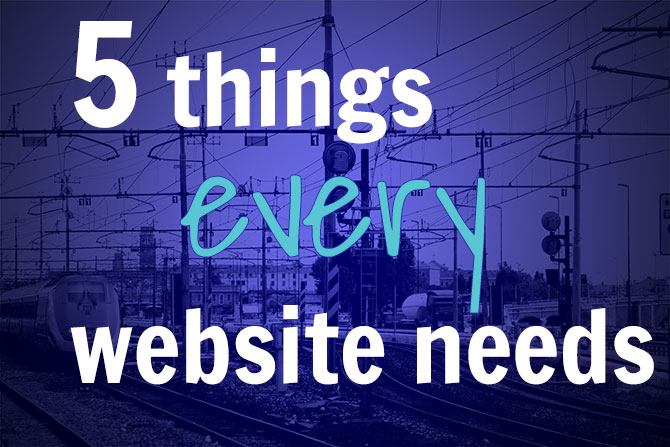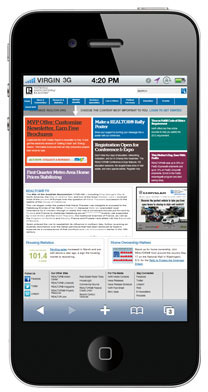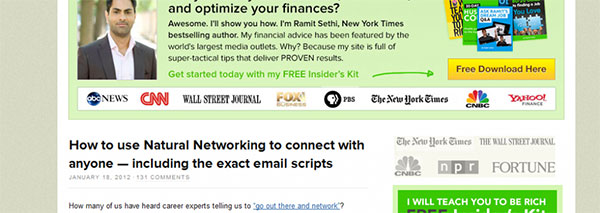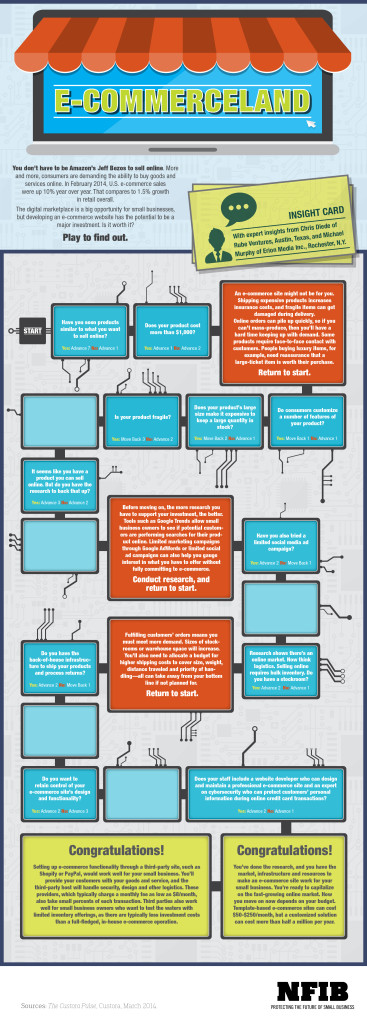5 ways to generate traffic to your website
Once you’ve established a solid foundation for your online presence (ie: you have the 5 things every website needs) it’s time to start building your audience. There are a number of ways to do this but I’ve narrowed things down to 5 that will give you the most bang for your buck.
1. The 80-20 Rule
Unfortunately “if you build it they will come” is something that only works in movies. You need to tell people about your website. And give them something worth visiting.
The best way to keep visitors coming back is by blogging or regularly creating valuable content. But when most people think of this activity, it sounds like an onerous and never ending task. But the reality is it can, and should, take less time than you think.
In the beginning it can seem like you’re working against gravity. You want traffic to your site so you create content because content attracts visitors. But you have to keep visitors coming back so you find yourself constantly creating new content. If you’re trying to do this all by yourself or even with a small team it can seem like you never have time to do the real work of your business.
Derek Halpern from Social Triggers is the first place I’d heard of the 80-20 rule applied to blogging and content marketing. Basically the 80-20 rule says you should spend only 20% of your time creating content and the remaining 80% promoting it. When Derek first launched his Social Triggers blog he had only a few posts. But they contained amazingly valuable information. And he promoted and leveraged the heck out of them to become known as the place to go to learn about psychology based internet marketing.
Now if you’re creating less content and promoting it more heavily, it needs to be really great and valuable enough that others will want to share it. A few surface-level paragraphs on a particular topic won’t do. I spent over 5 hours researching, writing, and editing my last article – “5 Things Every Website Needs”. But for the last few weeks I’ve promoted it and shared it in my newsletter and repeatedly on social media. And others have shared it too (thank you)! Now the “5 Things” post accounts for over 20% of the traffic to my website.
2. Guest Posting
Once you’ve got some content on your website, you can start to leverage other people’s audiences to build your own. (Remember, with the 80-20 rule you don’t need a lot of content. It just needs to be great.)
The mistake a lot of people make when looking for guest posting opportunities is to pick a site that is too similar to their own. We certainly want our expertise to be relevant to the audience where we’re guest posting. But the benefit of guest posting, when done properly, is exposure to an audience different from our own.
An example of some audience overlap might be my accountant guest posting on a tax lawyer’s website. But my accountant would get better exposure, to a new and different audience, if he guest posted on my own website. It’s still relevant because although I provide web design and development services, I’m focused on providing information to help you grow your business. So a post about technology-related tax deductions for businesses, for example, would be useful to my audience.
Kissmetrics has a great guide to guest posting that covers finding a site that’s the right fit, pitching a guest post, submitting it, and tracking the results.
Just before I published this article I saw an article from James Clear on why he stopped guest posting. His argument against guest posting is that it doesn’t scale well. He publishes two great articles to his blog every week. But he feels if he had to write more (to guest post) then the quality would decrease. He would also spend a lot more of his time writing.
Now instead of guest posting, James syndicates his content instead. In other words, he writes great content for his own site on a weekly schedule (Monday and Thursday). Then each week he takes the posts from the previous week and pitches them to be republished on other websites. In a sense, he’s leveraging the 80-20 rule since republishing to other sites is in essence promoting content he’s already created.
I think syndicating content like James does is a good strategy if you follow the tips in his article. I wouldn’t completely rule out guest posting however. In fact that’s how James originally made a name for himself. Guest posting may not be something you continue indefinitely, for some of the reasons James mentions, like scalability. But it is a good way to start getting traffic to your site.
Once you’ve made a name for yourself, like James has, other websites are incentivized to republish your content. When you’re just starting out however other websites may be reluctant to simply republish content that’s already appeared somewhere else. Part of the attraction of hosting guest posters in the first place is that it’s a relatively low effort way to get good quality unique content for your website. Having republished content from another source undermines the benefits (including unique SEO benefits) of that.
3. HARO
HARO or Help a Reporter Out is one of my best kept “secrets.” HARO is a service that connects experts with members of the media looking for sources for their news stories.
As a potential source, you can create a Basic Free plan and get opportunities by email three times a day. These opportunities include the summary for the story the reporter intends to write, the requirements for being a source (the particular expertise or angle they’re looking for) and a way to contact the reporter.
The New York Times, ABC News, and Huffington Post have all used HARO sources in their stories so this is a great way to not only establish credibility (social proof in the list of 5 things) but also get exposure to potentially huge audiences.
Like guest posting, we don’t want to respond to just any story we’re qualified for. We’re looking for the best audience fit. Personally I’d pass on a story about the top three responsive design tips for web designers. Although well within my expertise, the audience (web designers) aren’t a good fit for my business since they’re not likely to use my services.
I’ve found timing is important when responding to HARO leads. Requests for sources for stories on popular media outlets can generate hundreds of responses. So being one of the first qualified sources to respond helps. Follow any guidelines the reporter has established for submission and keep your response concise and to the point. Establish your qualifications and get to the information the reporter is looking for as quickly and clearly as possible. If the reporter needs additional information or clarification they’ll let you know.
Getting quoted by a well known media outlet can help establish credibility and send traffic to your website but don’t spend a ton of time on this activity. Like participation in social media, pitching stories can be a time suck if you’re not selective. I spend about five minutes reviewing stories when HARO emails arrive. And if I see something that looks promising (a good match with my expertise and an audience I want to reach) about 5-10 minutes composing and sending a pitch. Having a template ready with your bio and customizing your main message to that particular story can help save time.
I’ve got a 60% response rate so far and have been quoted on websites like the National Federation of Independent Businesses (a good fit for my business), American Express OPEN Forum (an ok fit but high traffic) and a WordPress security blog. These (some more than others) establish credibility for me, send traffic to my website, and also provide backlinks/SEO to my site.
For a more in-depth look at HARO, some tips for using it, and two case studies, check out the Heroic Search article “How to use HARO to earn valuable mentions and links.” It’s a great read.
4. Forums, discussion groups, chats
This is similar to guest posting, except that you’re not creating long form content. Your main goal for participating in these places is to be helpful, but not salesy. So this is a more “long tail” strategy for building an audience. Find out where people in the audience you want to reach hang out online then go there and help answer their questions and solve their problems. Yes this will take time. No you will probably not get an immediate reward. But over time you will build an audience who looks to you for your expertise. So you will be an easy choice when the time comes that they have a problem that your product or service solves.
It is important to note that you should be selective in where you participate based on where your ideal customers are. I recently left a discussion group when it became clear that although the participants could benefit from my expertise (they were mostly novices in this particular topic) the goal of their participation in this group was to obtain free advice. So they would never become paying customers of my business. Conversely, my business got a high five figure project with an organization because of expertise I continually demonstrated to a member of another discussion group. This member contacted me knowing I could solve his organization’s problem.
5. Webinars
Marketing software provider HubSpot has indicated their webinars “are the content that most effectively converts leads into customers.”
Webinars are a slightly more advanced technique for creating an audience because they involve special software and a little prep work. But they provide a way to showcase your knowledge and expertise to a large group simultaneously and in real time. You can also leverage webinars by recording them and reusing and repurposing the content.
Unlike other forms of content marketing, webinar audiences demonstrate more engagement with your message. They registered and blocked time in their calendars to attend after all.
Like participation in forums and chat groups, your primary goal in hosting a webinar is to provide value to your audience and be helpful. Providing value first helps establish your expertise and credibility. Identify the problem you solve for clients and the pain points that make it important that the problem be solved.
Once you’ve provided your audience with loads of free content during the webinar, your product or service is the (paid) way to get more of what you have to offer. Many will be ready to take the next step. So be sure to have something to offer them at the end.
Bonus! Email
Not to sound like a broken record but email is still the single best way to market your business. So make sure you’ve started your list (#4 of the 5 things every website needs). On an email related note, consider adding a link to your most recent content to your email signature. It takes just a few minutes to keep updated and most of us send lots of email every day. Last month 5% of my traffic came from the link in my email signature (see below).



 This doesn’t mean that your website must look exactly the same, down to the pixel, on all devices. But your site absolutely must function and be usable on desktops, tablets, and smart phones.
This doesn’t mean that your website must look exactly the same, down to the pixel, on all devices. But your site absolutely must function and be usable on desktops, tablets, and smart phones.





